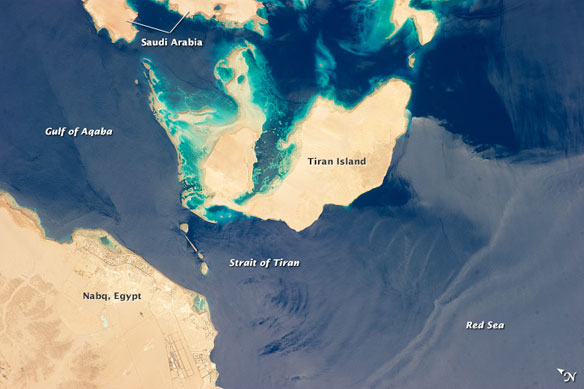
By William L. Stefanov, Jacobs/ JETS /NASA,
The six-kilometer-wide Strait of Tiran (also called the Straits of Tiran) between the Egyptian mainland and Tiran Island separates the Gulf of Aqaba from the Red Sea.
It provides two channels (290 meters and 73 meters deep, respectively) navigable by large ships bound for ports in Jordan and Israel; there is also a smaller passage between the east side of Tiran Island and Saudi Arabia, but this single channel is 16 meters deep. Due to its strategic location, control of the Strait has been an important factor in historical conflicts in the region, including the Suez Crisis in 1956 and the Six-Day War in 1967.
This photograph taken by an astronaut on the International Space Station (ISS) illustrates the morphology of the Strait.
The relatively clear, deep-water passages of the western Strait of Tiran are visible at image left, while the more sinuous, shallow-water passage on the Saudi Arabia side can be seen at image top center. Light blue to turquoise areas around Tiran Island indicate shallow water, while the island itself is arid and largely free of vegetation. Coral reefs are also found in the strait and are a popular diving destination.
The silvery sheen on the water surface within the Strait and the south of Tiran Island is sunglint—light reflecting off the water surface back towards the observer on the ISS. Disturbances to the surface, as well as presence of substances such as oils and surfactants, can change the reflective properties of the water surface and highlight both surface waves and subsurface currents. For example, a large wave set is highlighted by sunglint at image lower right.








